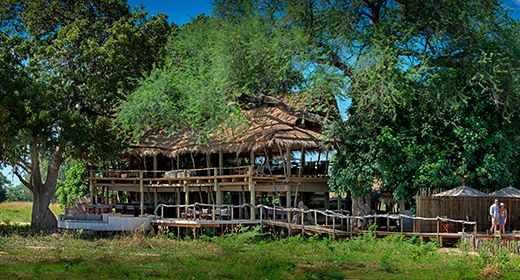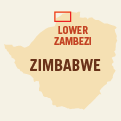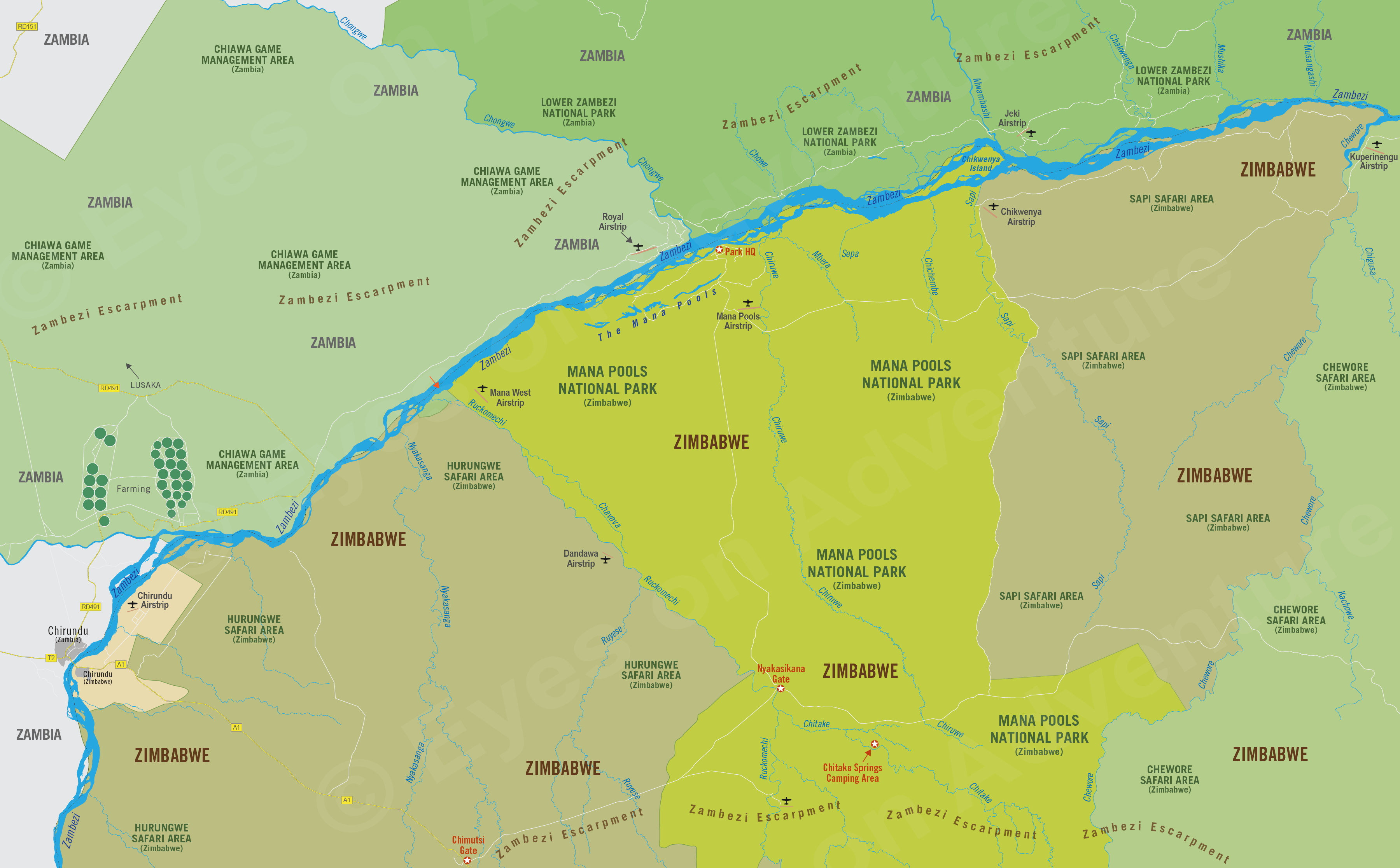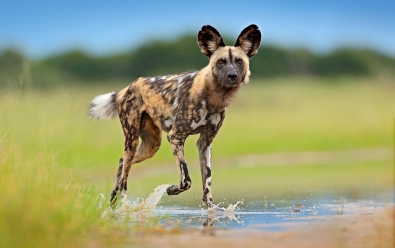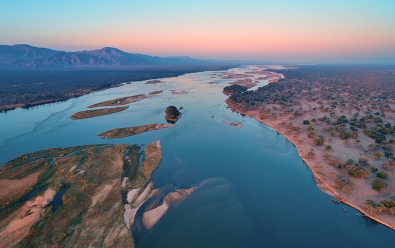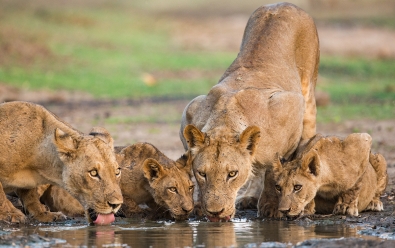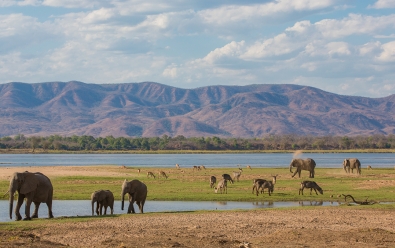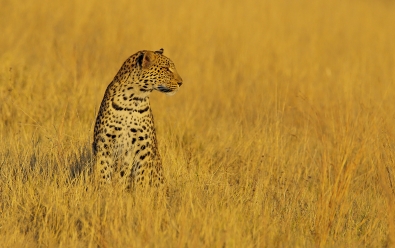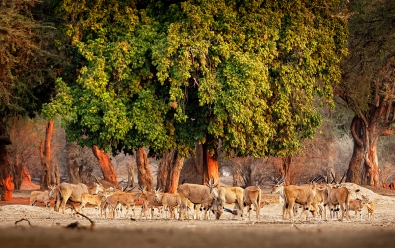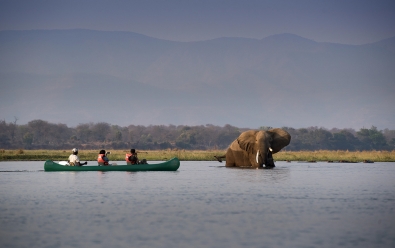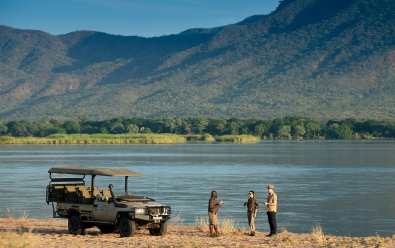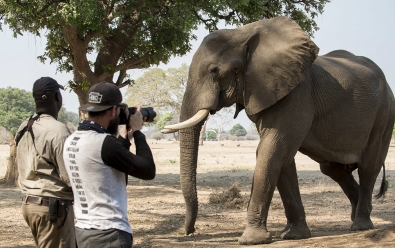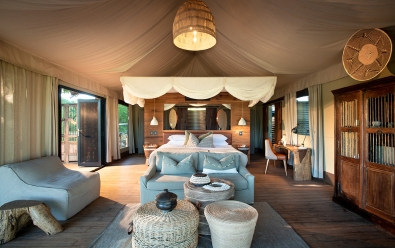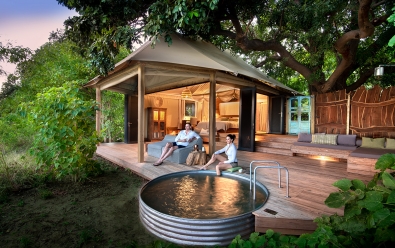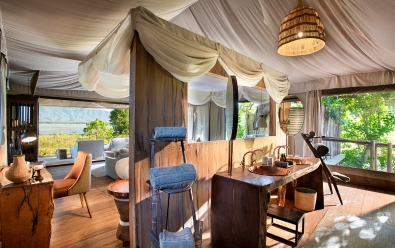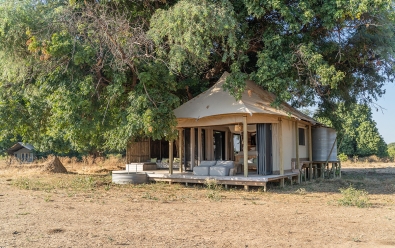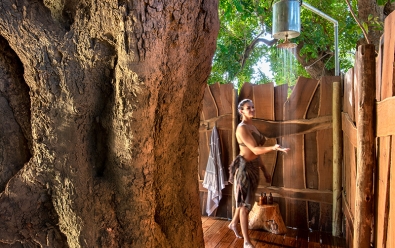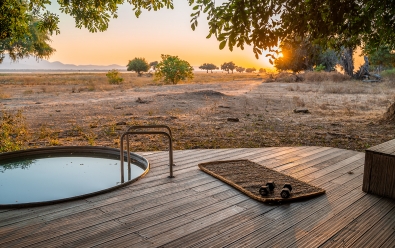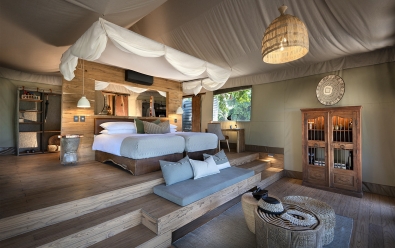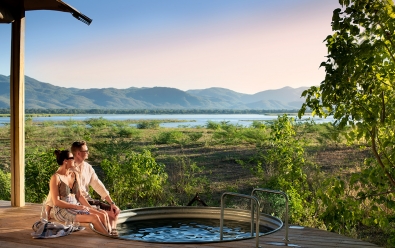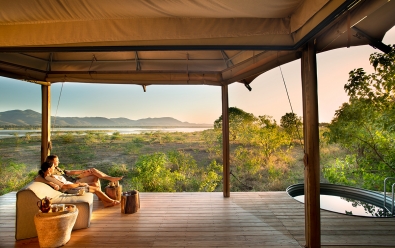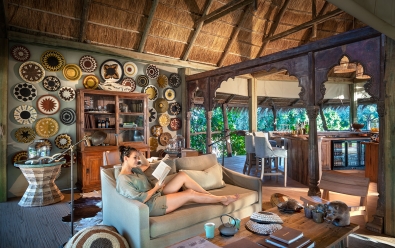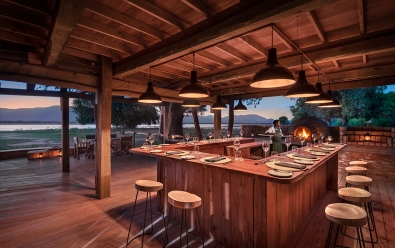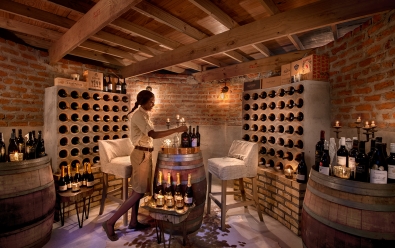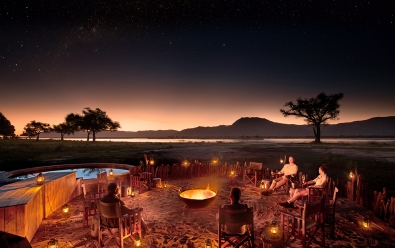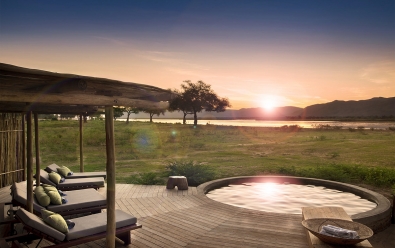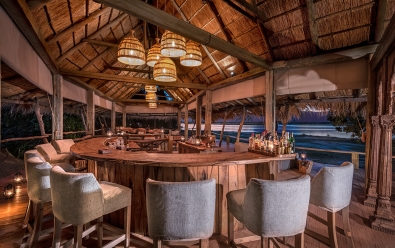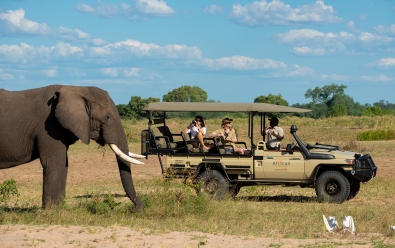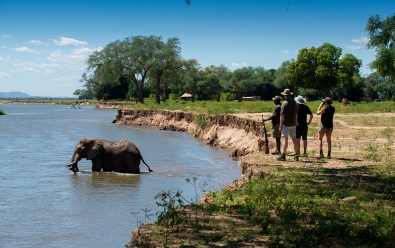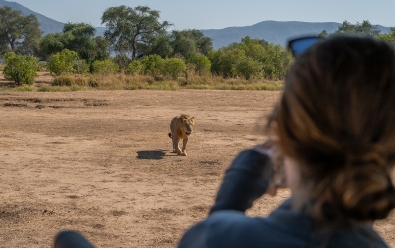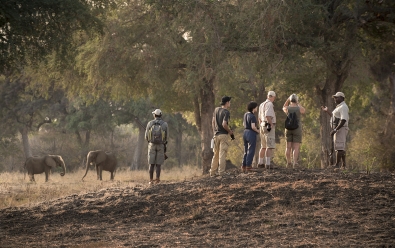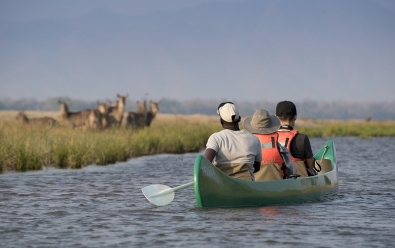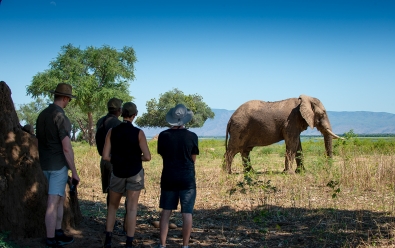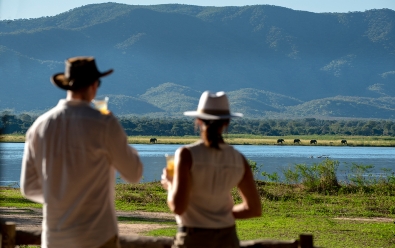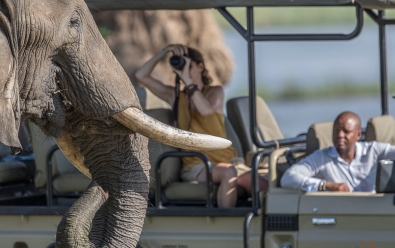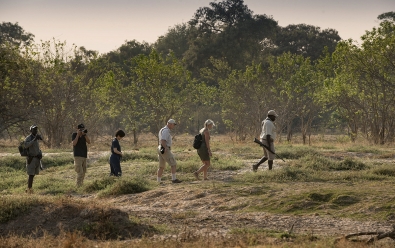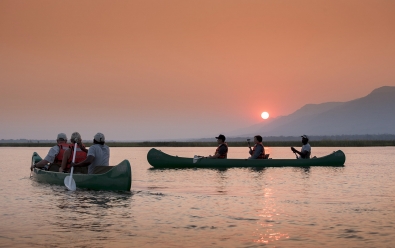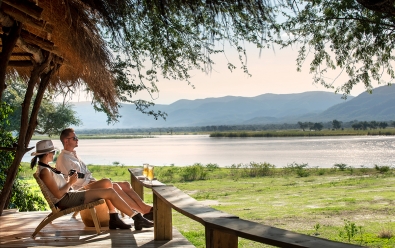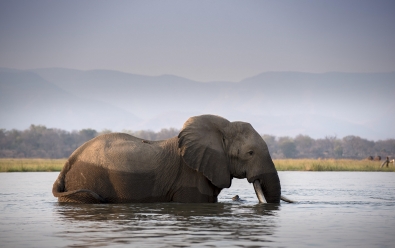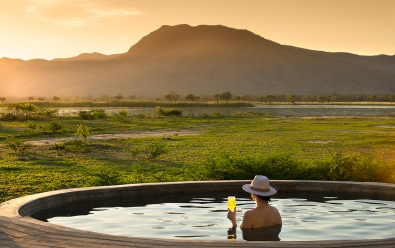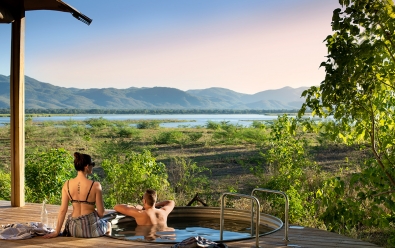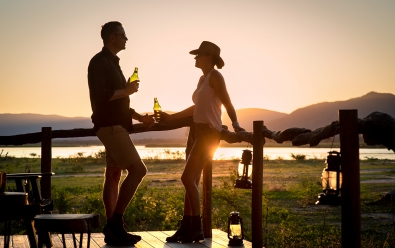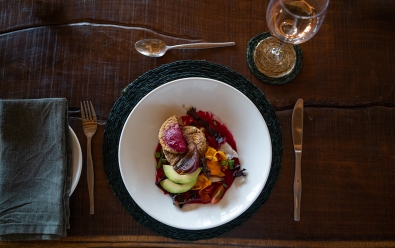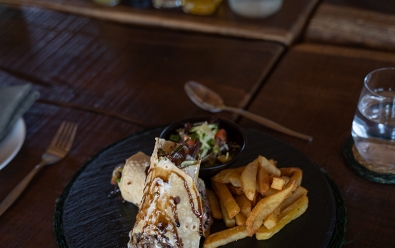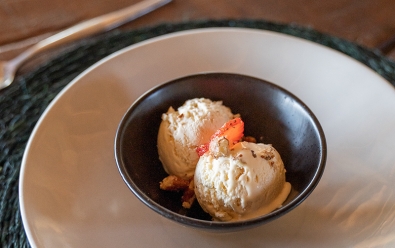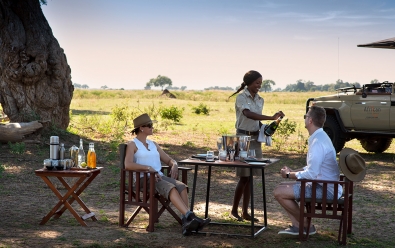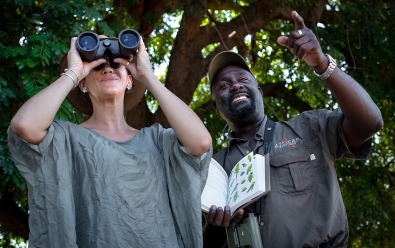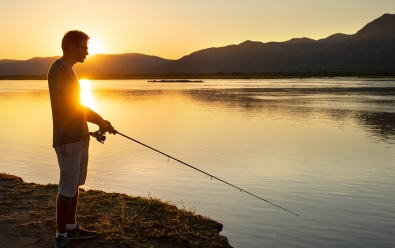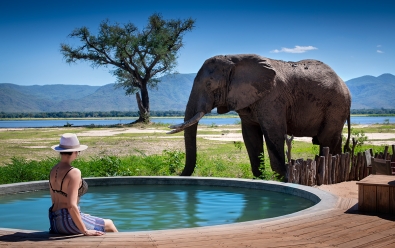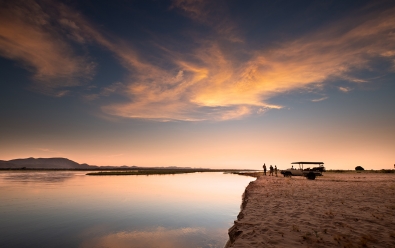Nyamatusi Camp
Highlights
- Located in a remote wilderness area along the Zambezi River.
- Superb wildlife viewing, especially during the dry season.
- Game drives, walking, canoeing, fishing, and seasonal boating.
- Very low tourist density with no other camps nearby.
Location
- Mana Pools National Park
- Lower Zambezi River
- Northern Zimbabwe
Nyamatusi is an upscale safari camp located on the banks of the Zambezi River in the remote and wildlife-rich Mana Pools National Park, which is part of a World Heritage Site.
Nyamatusi is adjoined to a smaller, family-oriented, sister camp (Nyamatusi Mahogany) and both camps are sited in an incredibly beautiful setting along the southern bank of the Zambezi River.
There are very few safari camps in Mana Pools National Park, and the Nyamatusi camps are located far from any other camp, giving guests here a very exclusive safari experience with no other tourists. Read all about Mana Pools below.
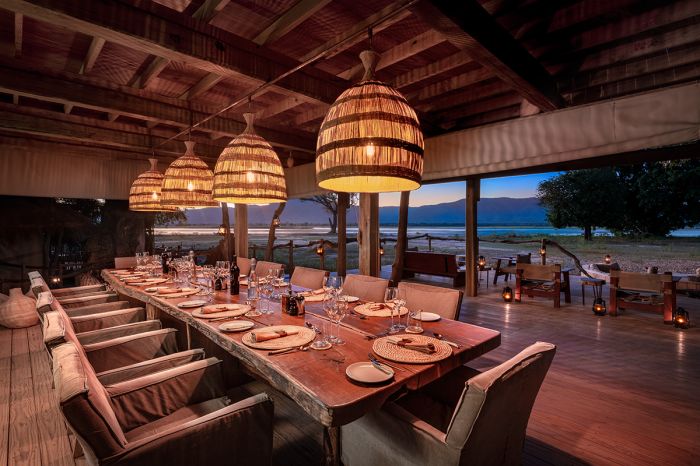
Main area dining at Nyamatusi Camp.
Wildlife is abundant around the camp, with seemingly endless numbers of elephant, which are regularly seen from the camp itself as they move along and across the river to and from Zambia's Lower Zambezi National Park, which lies on the far side of the waterway.
The elephants in Mana Pools are typically extremely relaxed around humans, and often amble slowly right through the camp, allowing for up-close viewing, both in vehicle, on nature walks, and from the camp.
Other iconic species that are likely to be seen at Nyamatusi include buffalo, eland, waterbuck, greater kudu, impala, and many more. Commonly seen predators include lion, spotted hyena, leopard, African wild dog, and black-backed jackal. Cheetah are present, but seen less often. Hippo and crocodile are abundant in the river. Birding in the area is extremely good, with over 400 species recorded.
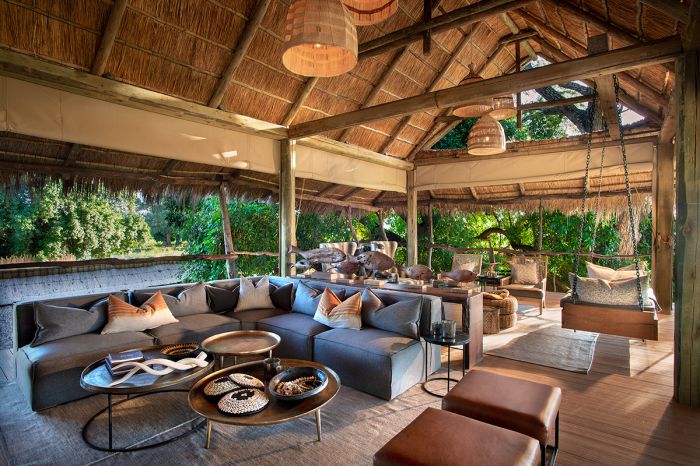
Upper-level lounge space at Nyamatusi Camp.
Activities at Nyamatusi Camp include twice-daily (or full-day) game drives in customized, open Land Cruisers, walking with an armed guide, canoeing on the Zambezi River, fishing (catch-and-release from the shore), and seasonal power-boat outings on the river. Wildlife viewing from the camp's main area and guest tents is also very good throughout the day between activities.
The camp offers six, luxurious, well-appointed, tented-suites, with comfortable beds (twin or double setup), an outdoor deck that includes lounge seating and a private, plunge pool, and fully-plumbed facilities with both indoor and outdoor showers, a double-basin vanity, and flush toilet.
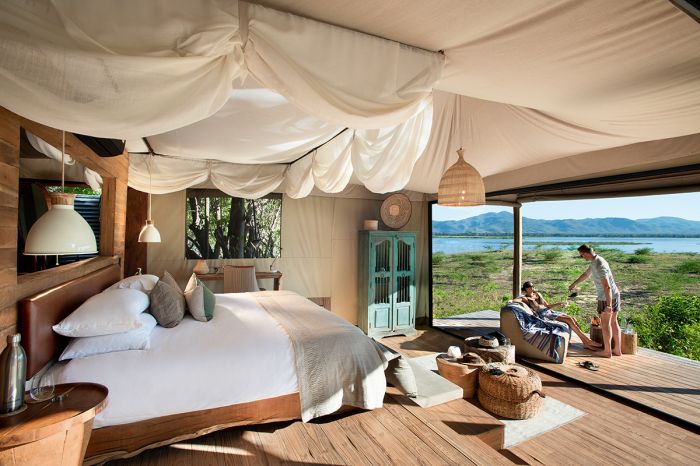
Guest tent interior and view to the Zambezi River.
The main camp area consists of a two-level wooden structure constructed atop wooden decking that overlooks the river and offers views all the way across the Zambezi River to the escarpment on the Zambian side. The slightly-elevated lower level features an indoor dining space, bar, and welcoming lounge area.
The indoor space opens at the front onto an outdoor deck used for dining and relaxing, as well as a sunken campfire area. The deck also offers a plunge pool with loungers for rolling off between activities. There is a safari shop offering African curious and safari gear.
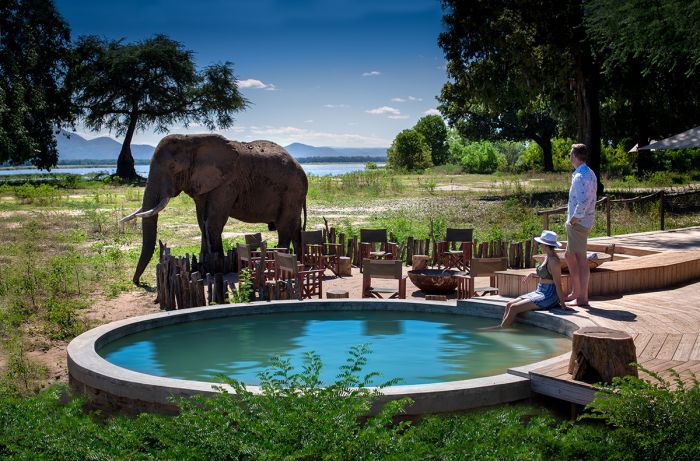
Main area campfire and plunge pool at Nyamatusi Camp.
Nyamatusi Camp is an eco-friendly safari accommodation that operates primarily on solar energy (guests can tour the impressive solar-panel array behind the camp), but a generator provides a backup power source and there is 24-hour electricity in the guest tents and the main area.
The Nyamatusi camps are owned and operated by African Bush Camps (ABC), a company founded by a professional African safari guide, who has a passion for protecting remote spaces and the wildlife that lives there.
African Bush Camps operates safari camps in Botswana, Zimbabwe, and Zambia. The ABC camps are fully sustainable, with minimal impact on the environment. The African Bush Camps Foundation runs local projects that empower the local communities wherever they operate safari camps. The company's aim is to conserve and preserve wildlife and natural areas in Southern Africa.
About The Lower Zambezi
Zimbabwe's Mana Pools National Park is located in the Lower Zambezi Valley, a remote protected area along the Zambezi River that covers land in both Zimbabwe (south of the river) and Zambia (north of the river). The Zambezi River forms the boundary between Zimbabwe and Zambia in this area. The Zambezi Valley is flanked on both sides by the rugged Zambezi Escarpment, which rises over 3 300 feet (1 000 meters).
The lifeblood of the entire Lower Zambezi Valley, including Mana Pools NP, is the Zambezi River, which originates hundreds of miles away in far northwest Zambia. This mighty river flows south through Zambia, over The Victoria Falls, east into Lake Kariba and into the Lower Zambezi Valley.
The Zimbabwean side of Lower Zambezi includes Mana Pools National Park and the adjoining Sapi and Chewore Safari Areas further east and was declared a UNESCO World Heritage Site in 1984. The Zambian side of the river is protected by Lower Zambezi National Park and the Chiawa Game Management Area.
The combined protected areas of the Lower Zambezi are one of Southern Africa's most diverse wildlife destinations and one its most outstanding wilderness areas.
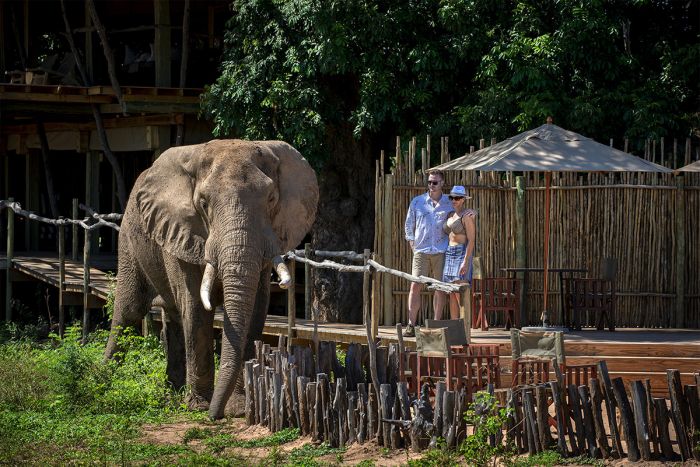
Elephants are commonly seen as they pass thru Nyamatusi Camp.
About Mana Pools
Mana Pools is part of an extensive, unfenced natural habitat that is home to diverse and abundant wildlife on the southern side of the Zambezi River. The combined protected area includes Mana Pools National Park (848 sq mi/2 196 sq km), Sapi Safari Area (456 sq mi/1 180 sq kms), and Chewore Safari Area (1 309 sq miles/3 390 sq kms) and stretches east to the Mozambique border.
The national park is named for four semi-permanent pools just south of the river that are remnants of a prior river course and are now a favored refuge for large numbers of hippo and crocodile. The word 'mana' means 'four' in the local Shona language.
Mana Pools is well known for its superb wildlife diversity, as well as its beautiful scenery. The park is one of the most remote in Southern Africa and one never need worry about many tourists, as the small number of safari camps means it can never be crowded. The area truly feels untouched by time.
Four of Africa's Big Five animals are found in Mana, including elephant, lion, leopard, and buffalo. Black rhino once existed here, but they are now gone.
Mana is perhaps most known for its elephants, especially the good number of extraordinary big bulls, which are very relaxed by nature and often wander through the safari camps, casually feeding while taking little notice of any humans. One popular sight which you may be lucky to see is one of these big bull elephants standing on only its two rear legs to reach high into a tree for tasty seed pods.
Buffalo are seen in good numbers, either in breeding herds or small groups of old bulls. Like the elephants, buffalos freely cross the Zambezi River back and forth between Zimbabwe and Zambia, often stopping on one of the numerous river islands to graze.
Lions are not difficult to find, especially during the dry season when they remain near the river floodplains, which are teeming with wildlife during the winter months. Leopards are more elusive but are seen regularly. Spotted hyenas are here in good numbers, as are black-backed jackal. Cheetah are present, but only seen occasionally.
Mana is one of the best places in Africa to see African wild dogs, with several oft-seen packs traversing the area. These entertaining predators are seen regularly as they hunt the floodplains along the river in the early morning or near dusk.
Besides the abundant predators, Mana Pools is home to a large variety of herbivores, including impala, zebra, waterbuck, bushbuck, greater kudu, and warthog. The region is one of the best places in Southern Africa to see eland, the continent's largest antelope. Giraffe are not found in Mana Pools and there is no evidence that they ever existed here.
The Zambezi River itself is home to a huge number of hippo and crocodile and anyone canoeing or boating on the river is sure to see plenty of both species. Pods of hippo can be seen sunning along the river banks are more often just wallowing in the shallows along the banks.
Bird life is abundant in Mana Pools, with over 400 species recorded. Large colonies of beautiful carmine bee-eaters use the river banks for nesting holes and African skimmers use sand flats for their nesting.
ROOMS INCLUDES & EXCLUDES CHILDREN FACILITIES ACTIVITIES
Accommodation
6 guest accommodations in total comprising:
- 6 wood-and-canvas, luxury tented-suites, each with two three-quarter beds and a spacious outdoor deck with a private plunge pool and lounge seating. The beds can be converted to a double bed on request.
All the guest suites feature air conditioning and fully-plumbed, en-suite facilities that include an indoor shower, outdoor shower, double-basin vanity, and a flush toilet.
The guest suites are constructed atop slightly-elevated, wooden platforms with sand footpaths leading to the main camp area.
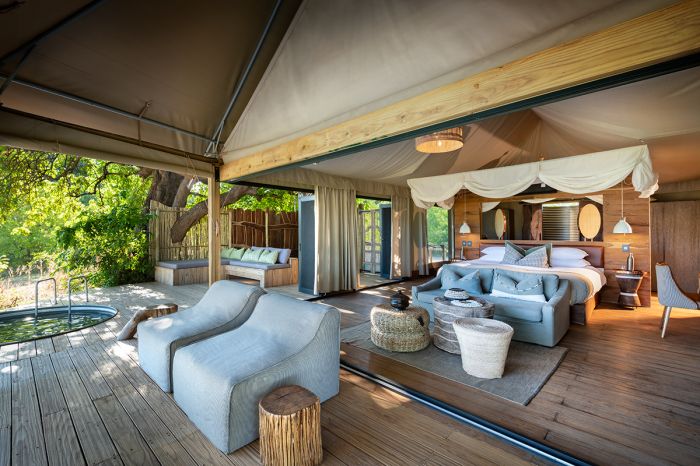
Guest tent bedroom and private deck with plunge pool at Nyamatusi Camp.
Other items and features in the guest suites include:
- Air conditioning.
- Mosquito netting over the beds.
- Couch and daybed.
- Clothes storage / wardrobe.
- Writing desk and chair.
- Pedestal fan.
- Outdoor veranda/deck with day-bed, lounge charis, and private plunge pool.
- Mini-bar with fridge.
- Coffee/tea station.
- Light free-weights.
- Electronic safe for storing valuables.
- Walkie-talkie radio to call the camp office.
- Multi-plug charging station.
- Personal amenities, including laundry basket, robe and slippers, liquid soap, body wash, shampoo and conditioner, insect repellent, insect spray, room spray, vanity kit with cotton-tip swabs and cotton wool pads, shower cap, and umbrella.
Nyamatusi Camp can accommodate a maximum of 12 guests in total: 2 guests in each of the 6 guest tents.
Includes & Excludes
Includes:
- All meals and local beverages including wines, spirits and liqueurs, but excluding premium imported brands and Champagne.
- Twice-daily safari activities including game drives in open game-viewing vehicles, nature walks, catch-and-release shore-fishing, canoeing, seasonal boating, and other scheduled camp activities (all accompanied by experienced guides).
- Laundry services are provided on a daily basis (weather permitting, items will be returned on the same day). Laundry is dried by the sun and on most days any laundry placed out in the morning will be returned by the evening.
- Mana Pools airstrip road transfers.
- Boat transfers from Chirundu during rainy season (depending on road conditions).
- Tourism Levy & VAT.
Excludes:
- Premium imported beverages and Champagne.
- Any applicable wildlife fee, park fee, reserve fee, concession fee, other land-use fee.
Single Supplement
A single supplement will apply for any room booked by a single traveler; please ask us for pricing.
Children
Children aged 7 years and older are accommodated at Nyamatusi Camp.
- Best option for families with children is to stay at the adjoining property, Nyamatusi Mahogany Camp, which has 2-bedroom family tents.
- Children under 16 years of age are charged a child rate and must share with an adult/s in the same suite.
- Children aged 16 years and older will pay applicable adult rates and can be accommodated in a separate tent or sharing with a parent.
- Families with children will be accommodated in the same vehicle as other guests for game drives. Private vehicles are an option (subject to availability and at additional cost).
- Walking and canoeing activities are available to guests aged 16 years and above.
- Ngwana Club is a family-friendly program that offers kids of all ages a variety of safari-related activities.
- Young children must be supervised by their parents, as the camp is not fenced and is located in an area with wild animals.
Facilities
Nyamatusi Camp is located adjacent its sister camp, Nyamatusi Mahogany Camp, on the bank of the Zambezi River in Mana Pools National Park. The area is remote and located far from any other safari camps.
The main camp area consists of a two-level wooden structure constructed atop wooden decking. The front and sides of both levels are open-air, with roll-down, weather-proof flaps in case of rain. The second level has a high-pitched roof made from local, reed thatching.
The lower level is slightly elevated off the ground and features an indoor dining space, bar, and welcoming lounge area. The indoor space opens at the front onto an outdoor deck used for dining and relaxing, as well as a sunken campfire area. The deck also offers a plunge pool with loungers for rolling off between activities.
The upper level offers more lounge space, an interactive dining bar with fired, brick-oven, and an outdoor deck for superb views of the Zambezi River, floodplains, and across the river to Zambia's Lower Zambezi National Park.
The well-stocked Safari Shop offers African curios and other items for sale. Behind the main guest area is the camp's solar-power system, featuring a large array of solar panels that provides electricity to the camp.
Main guest area facilities include:
- Two-level, semi-open, lounge, dining, and bar area under thatch on a raised wooden deck.
- Outdoor viewing decks on both levels with lounge seating.
- Plunge pool and sundeck.
- Sunken campfire area.
- Wine storage and tasting room.
- Guest toilet in the main area.
- Safari shop with items for purchase.
Activities
Activities included in the rate:
- Morning and afternoon game drives in 4x4 Land Cruisers.
- Walking safaris with armed guide.
- Canoeing on the Zambezi River.
- Birding.
- Catch-and-release, shore-based fishing.
- Boating on the Zambezi River (available Nov and Dec, subject to water levels).
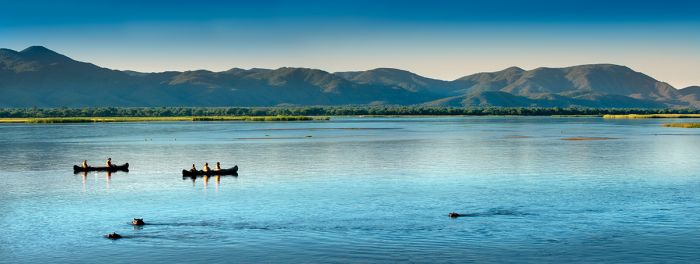
Canoeing on the Zambezi River.
Optional activities at additional cost:
- Private activities are on offer (subject to vehicle availability, which needs to be booked in advance)..
Example of a typical day:
- Early morning wake-up call. Morning wake-up and activity times vary according to the seasons, activities on offer, and wildlife sightings.
- Light breakfast before departing on the morning activity.
- Return to camp for a meal and rest period.
- Meet for afternoon tea and snacks (savory and sweet choices) before departing on the activity.
- Return to camp - freshen up or meet for drinks, followed by dinner.
- Enjoy a nightcap or discussion around the fire before retiring.
Great Good Fair Poor
- Jan
- Feb
- Mar
- Apr
- May
- Jun
- Jul
- Aug
- Sep
- Oct
- Nov
- Dec
When To Visit
Like most of Southern Africa, the Mana Pools area has distinct seasonal variations that are primarily determined by local rains. Temperatures are mild to very warm all year.
The summer/rainy season begins around mid-November and continues into mid-April. During this time, much of the park and its game drive tracks become very difficult or even impassable and many of the safari camps are closed or have limited activities at this time.
The winter/dry season (from June through October) is the best time to visit Mana Pools.
Nyamatusi Camp is open from 01 April to 05 January (closed 06-Jan thru 31-Mar).
WINTER / DRY SEASON
The dry season is the best time to visit the Lower Zambezi and Mana Pools National Park. The season runs from May thru October and during this time, there is almost no rain whatsoever. The wildlife viewing is at its best in winter, with herds of elephant, buffalo, and antelope congregating along the permanent waters in the Zambezi River. Rainwater pans and minor waterways inland from the Zambezi River dry up up as the season progresses and the animals are forced to remain close to the river.
Many of the safari camps in the area are only open during the dry season, but due to the very low density of accommodations here, the national park and areas bordering the park are never crowded and you may not see any other people other than those in your camp.
May is a lovely time to visit, with lush, green vegetation still covering the landscape. Late rains are possible, but most days are sunny and clear. Daytime temps average 73-77°F (23-25°C), with overnight lows averaging 49-51°F (9-11°C).
June and July are the chilliest months of the year and rain is extremely unlikely. The bush begins to lose its verdant color and by late July, has become dry. Daytime temps are warm, averaging 75-78°F (24-26°C), but the early mornings are chilly and morning game drives will require dressing in layers. Overnight temps drop to an average of 47-51°F (8-10°C). Wildlife viewing, particularly around and remaining water sources and along the Zambezi River, is very good.
August and September are the very best months to visit the Mana Pools area. Game viewing is outstanding, especially along the Zambezi River, as it is basically the only water source until the rains come in November/December. The landscape is now very dry and the only good grazing is on the floodplains along the Zambezi River, where herds of elephants, zebra, buffalo, waterbuck, and other species congregate to feed. Temperatures are rising, with daytime highs reaching 86-91°F (30-33°C) and nights and early mornings only falling to a pleasant 55-63°F (13-17°C).
October is by far the warmest and driest month of the year. Wildlife viewing continues to be outstanding, with the river floodplains teeming with animals. The best time for safaris is early in the day before the sun gets too high and again later in the afternoon. Midday temperatures average 93-98°F (34-37°C) and the overnight temps only drop to 66-69°F (19-21°C). Due to the very warm days, safari drives are shorter, with animals seeking shade from mid-morning until late-afternoon.
Summer / Rain Season
The first rains typically fall anytime from late-October to mid-November, bringing relief to the parched landscape and the wildlife. The early part of the season is still a very nice time to visit the Mana Pools region, with fresh grasses and new vegetation starting to emerge. Some herbivores, particularly impala, time their birthing season to coincide with the arrival of the summer rains.
November rains usually only occur every other day or so on average and are typically afternoon showers only lasting 1-2 hours. Temperatures are still quite warm, with daytimes averaging 88-92°F (31-33°C). Afternoon showers cool things down if they occur. Overnight temps drop to around 64-67°F (18-19°). Some safari camps may close for the season during November.
December through February receive the most rain, with most days receiving at least some precipitation, but all-day rains are unusual. Game-drive roads can become difficult or unusable at this time. The smaller waterways, which are typically dry for most of the year, are now flowing and wildlife disperses away from the Zambezi River towards the Zambezi Escarpment to feed on the abundance of fresh vegetation. Wildlife viewing becomes somewhat more challenging, with animals now spread out away from the river.
March is approaching the end of the rainy season, with showers decreasing in frequency and volume. Temperatures are roughly the same from December through March, averaging 82-88°F (28-31°C) during the day and 64-70°F (18-21°C) overnight.
April is the transition month between the rainy and dry season, with only sporadic showers and gradually decreasing temperatures. The bush is verdant and thick after the months of rainy days and some safari tracks may still be difficult for driving. Daytime temps average 84-86°F (29-30°C) and overnight/early morning temps are comfortable, averaging 51-54°F (10-12°C).




